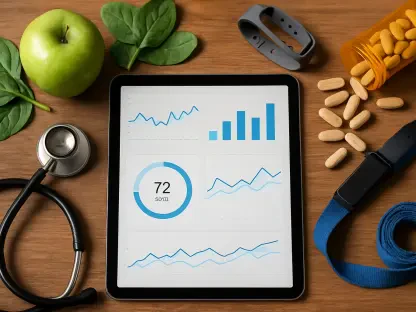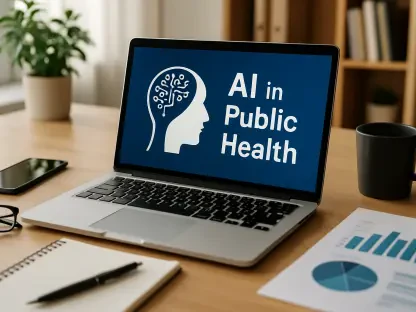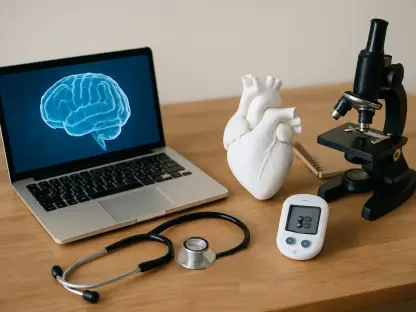In a world where healthcare is rapidly evolving with technology, James Maitland stands out as a remarkable expert in robotics and IoT applications in medicine. His passion for utilizing technology to enhance healthcare solutions makes his insights particularly valuable for navigating the future of medical advancements. Today, we dive into the significant discussions from AHIP 2025, exploring how industry leaders like Aetna and Anterior are shaping the future of healthcare.
What were some of the key themes discussed at AHIP 2025?
AHIP 2025 was a platform rich with discussions on affordability, AI advancements, and the intersection of food and healthcare. The backdrop of Medicaid cuts in Congress highlighted a need for innovation and reform. These conversations centered around addressing consumer trust, enhancing patient care, and integrating technology to streamline processes. The idea was to shed light on the evolving insurance landscape and its challenges while opening the door for future solutions.
How is Aetna tackling consumer distrust and complaints in the healthcare industry?
Aetna’s approach begins with acknowledging the root issues behind consumer distrust, primarily perceptions of incompetence and deliberate complicacy. Steve Nelson, Aetna’s president, emphasized that the organization is neither incompetent nor trying to be difficult on purpose. His focus is on improving transparency and simplifying processes, particularly through enhanced digital solutions to transform the negative perceptions into trust-building opportunities.
In what ways is Aetna simplifying the prior authorization process for its members?
Aetna is actively reducing the complexities associated with prior authorization by bundling approvals for common conditions such as breast cancer, which typically require multiple imaging procedures. By doing so, they aim to streamline the process and enhance efficiency. Additionally, Aetna, along with other insurers, committed to lessening the number of services subject to prior authorization, aiming for broader implementation next year.
Can you explain how Aetna’s app assists enrollees with the prior authorization process?
The Aetna app facilitates real-time tracking of prior authorization claims, resembling a food delivery tracking system. Users can see the status of their authorization requests—whether pending, approved, or denied—similar to how customers follow their orders. This transparency not only aids enrollees in understanding their claim’s journey but reduces anxiety by providing clarity at every step.
What are some features of Aetna One Advocate, and how does it aim to improve patient care?
Aetna One Advocate offers a concierge-like service that connects providers and members, enhancing engagement and personalization. It includes comprehensive support for discharge planning, transportation, and meal planning, ensuring seamless transitions from hospital care to home. This attention to detail and member support helps elevate patient satisfaction and the overall healthcare experience.
How does Aetna collaborate with hospitals to enhance patient discharge planning?
In collaboration with hospitals, Aetna embeds its services into discharge processes, focusing on transportation, nutrition, and caregiver support. This integrated approach aims to provide patients with a smooth transition from inpatient care to home, reducing readmissions and promoting better health outcomes by addressing social determinants of health.
What is the difference between the “food as medicine” and “nutrition as medicine” models?
The “food as medicine” model is primarily about addressing food insecurity and ensuring access to healthy foods. However, “nutrition as medicine” goes beyond, focusing on personalized nutrition solutions integrated into healthcare treatments. This model proposes specific dietary plans tailored to individual health needs, emphasizing food’s role in proactive healthcare and disease prevention.
How does Dr. Dariush Mozaffarian propose integrating nutrition into healthcare treatment?
Dr. Mozaffarian advocates for personalized nutrition counseling and prescribed meals as part of regular healthcare treatment. His approach includes creating infrastructure to support these prescriptions, ensuring patients receive the right nutritional support according to their health challenges. The idea is to move beyond conventional advice to incorporate clinical nutrition strategies that genuinely impact patient health.
What challenges exist in implementing “nutrition as medicine,” and how can they be addressed?
The primary challenges in implementing “nutrition as medicine” include developing payment models and establishing vendors to support food-as-treatment programs. Addressing these requires collaborative efforts to align healthcare practices with nutrition-based treatment plans and ensuring the financial and logistical frameworks are in place to sustain them effectively.
Why is it important for healthcare organizations to embed cybersecurity into their company culture?
Embedding cybersecurity into company culture is crucial to protect sensitive patient data and maintain trust. With increasing cyber threats, healthcare organizations must ensure that every employee understands their role in cybersecurity, regardless of their technical expertise. This holistic approach means viewing cybersecurity as integral to patient care and organizational responsibility.
How can individuals within a company contribute to its cybersecurity measures without tech expertise?
Individuals can contribute by adopting a security-conscious mindset, recognizing potential threats like phishing, and following best practices for data protection. Regular training and awareness programs are essential to equip employees with the necessary knowledge and vigilance to be effective custodians of cybersecurity within the organization.
What role does governance play in addressing cybersecurity, especially with the rise of AI in healthcare?
Governance ensures that cybersecurity measures are designed to address the complexities specific to healthcare. As AI becomes more prevalent, governance structures help define accountability and oversee ethical AI use, prioritizing patient privacy and maintaining data integrity. They provide a strategic framework to integrate advanced technologies securely and responsibly.
What warnings did Paul Markovich offer about the sustainability of the U.S. healthcare industry?
Paul Markovich highlighted the unsustainable nature of the current healthcare system, viewing it as a “negative productivity” economy. He warned of an impending cliff, where the financial burden cannot be sustained by governments, employers, or consumers. His call to action points toward reevaluating the industry’s practices to find more sustainable solutions.
How is Blue Shield of California changing its pharmacy distribution approach, and why?
Blue Shield of California is moving away from traditional pharmacy benefit managers like CVS Caremark, preferring to work directly with manufacturers to access lower-priced drugs. The goal is to eliminate rebates and fees that inflate costs and create a distribution model where service providers are paid purely for their roles, not influenced by drug prices.
What are Paul Markovich’s views on top-down government reform in healthcare?
Markovich advocates for top-down government reform as essential for significant healthcare change. He believes that initiatives like nationwide digital health records—already technologically feasible—could streamline patient care and improve system efficiencies, urging the government to take decisive action in implementing these reforms.
What does Abdel Mahmoud believe about the future of prior authorization in healthcare?
Abdel Mahmoud envisions a future where AI makes prior authorization obsolete, removing the burden on healthcare providers and maximizing efficiency. His approach involves minimizing human involvement to transform prior authorization into a background activity, enabling healthcare professionals to focus on more impactful tasks.
How does Anterior’s AI platform intend to streamline the prior authorization process?
Anterior’s AI platform automates the collection and analysis of medical data, efficiently compiling reports for review by medical assistants. It simplifies data retrieval and enhances the decision-making process, ensuring no claim is rejected without human oversight. This shift allows specialists to supervise AI work, freeing them from monotonous tasks.
What potential benefits does Anterior’s AI offer to healthcare professionals?
Anterior’s AI offers healthcare professionals the ability to streamline administrative tasks, improve patient-data accuracy, and reduce workload. By enhancing efficiency, professionals can dedicate more time to patient care, thus improving service quality and healthcare outcomes.
How might AI change the roles of skilled specialists in the healthcare industry?
AI in healthcare can shift specialists’ roles from task execution to supervision, allowing them to focus on complex cases that require human judgment. It’s about leveraging AI to handle routine tasks, enabling specialists to concentrate on areas where their expertise can truly make a difference, thus redefining the scope of their work.
What are some challenges Anterior is facing in revolutionizing the prior authorization process?
Anterior faces challenges in widespread adoption and integration within existing medical systems. Overcoming resistance to change, aligning AI capabilities with healthcare compliance standards, and ensuring seamless interplay between human and AI processes are essential hurdles that require careful navigation to revolutionize the process effectively.
How can data structuring improve patient care, according to Abdel Mahmoud?
By structuring data immediately as it’s collected, healthcare providers can proactively address patient needs and improve care delivery. This approach enhances data utility, making it readily accessible for care management tasks, thereby improving health-plan ratings and overall patient outcomes through timely interventions.
What future revenue streams does Anterior anticipate as AI adoption broadens?
As AI solutions become widely adopted, Anterior anticipates revenue growth from new applications, such as advanced clinical decision support systems and personalized health recommendations. These innovative streams will expand naturally with the increased integration of AI in mainstream healthcare practices.
Why does Abdel Mahmoud emphasize understanding health plans’ medical loss ratios?
Mahmoud stresses the importance of understanding medical loss ratios to recognize that health plans aim to allocate premiums effectively. Rather than merely denying claims, plans seek to manage funds responsibly. Insight into these ratios helps startups tailor solutions that align with the financial realities and objectives of health plans.
How does the perception of health plans differ between startups and industry insiders, according to Mahmoud?
Startups often view health plans with skepticism, focusing on their claim denial tendencies, whereas insiders understand the complex financial and regulatory frameworks they operate under. Mahmoud emphasizes that bridging this perception gap requires deeper engagement with health plans’ goals and constraints to foster solutions that benefit both sides.
Do you have any advice for our readers?
In navigating the complex landscape of healthcare technology, remain open to innovation and collaboration. Understand the potential of AI and IoT in transforming patient care and workplace efficiencies. Stay informed and proactive in embracing changes that can lead to substantial improvements in healthcare delivery and outcomes.









